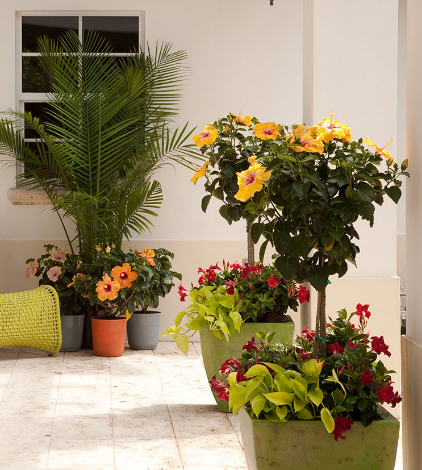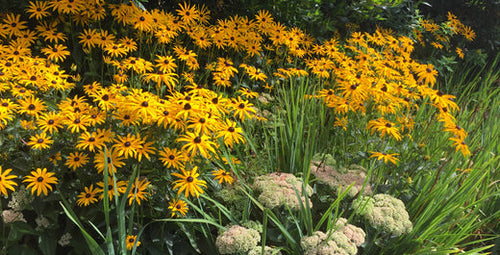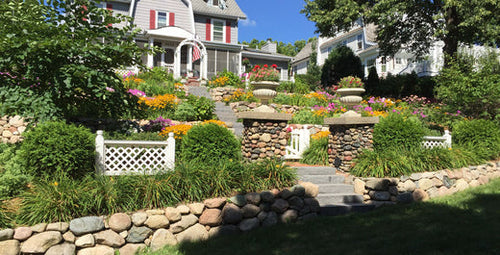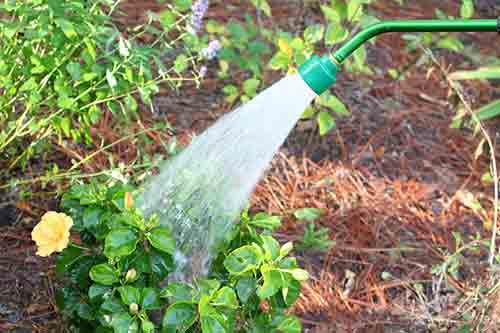
Daylily
One of the hardest working perennials on the planet, daylilies are a must-have plant for any deck-side container. These low-care beauties send up graceful spikes of trumpet-like flowers throughout the summer, but even when not in bloom, the plant’s grassy foliage looks great on its own or paired with other flowers. Flower colors include yellow, peach, red, purple, white, orange, and bi-color. Some daylilies are designed to provide a one-time mass of bloom in mid- or late summer, while others rebloom, producing a series of smaller blooms throughout the growing season. Plant a mix of both for best effect. Sun-loving daylilies tolerate dry soil and have few insect or disease problems.

Salvia
If someone made a buddy movie about perennials, salvia would be the co-star that stole every scene. That’s because these hardy plants show off glamorous blue, purple, pink, or white flowers that look absolutely stunning especially when paired with other flamboyant bloomers. Perennial salvia grows 15 to 24 inches tall, and develops vertical spikes of bloom in the early summer. Prune the plant back by a third of its height after the flowers fade and you get to enjoy an encore of color later in the season. Perennial salvia loves the spotlight, requiring 6 to 8 hours of direct sun a day. Plus, perennial salvia is a butterfly and hummingbird magnet.
Check it out: More perfect perennials for attracting butterflies.

Juncus
You don’t always need blooming plants to make a bold statement in pots and planters. Juncus, for example, develops striking, richly toned foliage that looks good all day, every day. Most have vertical foliage, but there are also varieties with fantastic, twisted, corkscrew-like leaves. Juncus grows 12 to 24 inches tall and makes an ideal partner to any perennial or annual flower. Or, planted by itself, juncus makes a bold architectural statement in a pot or planter. Juncus prefers full sun, but will also grow in partial shade. It’s not fussy about soil and will tolerate moisture extremes.

Coreopsis
Simply irresistible! The cheerful flowers of coreopsis will bring a smile to your face, even on a cloudy day. These easy-care perennials develop wave after wave of daisy-like flowers in yellow, gold, pink, red, white, or bi-color. Growing 12-18 inches tall, coreopsis is also a great choice for container gardens on a sunny deck or patio. Coreopsis flowers are borne on wiry stems that make them a great cut flower for indoor bouquets. To prolong the bloom season, clip the plants back by about a third after the first flush of flowers fades.
Discover more easy-care perennials every garden should have.

Aster
If your planters lose a little steam in the late summer, give them a refreshing burst of cool color by adding asters. Perfect mounds of blue, purple, or white flowers smother each plant from August to October. Their nectar-rich blooms will also transform your landscape into a butterfly haven. Asters vary in height from 8 to 36 inches tall and prefer a sunny spot on your deck or patio. Tall varieties might require staking to keep them from flopping over the edge of your planters.
Get more tips for adding late-season color to your yard.

Canna
Big, bold, and beautiful! That’s how we describe cannas. These bounteous beauties grow between 2 and 4 feet tall and produce a nonstop show of yellow, orange, red, or bi-colored blooms over a base of giant green, black, burgundy, or striped leaves. For a dramatic effect, plant cannas in tall pots and place them in the corner of your deck or patio or use them to line a walk or pathway. Though they're technically perennials, in cold-winter climates, you'll need to dig and store canna tubers in a frost-free place over winter. Cannas will also attract hungry hummingbirds to your yard.

Alstroemeria
Once used primarily in the florist trade, alstroemeria, or Peruvian lily, makes a wonderful plant for pots, planters, or directly in the garden. These prolific bloomers produce quantities of red, yellow, white, purple, lavender, or bi-colored flowers on tall, cut-able stems that can last up to two weeks in a vase. Most of the flowers are also attractively spotted or streaked with darker colors. The plants generally bloom in the late spring or early summer, slowing down once temperatures rise. Alstroemeria grows 1 to 3 feet tall, grows in full or partial sun and is hardy down to 25 degrees F.

Chrysanthemum
Fall is a great time to invite friends and family over for a barbecue or party. But, is your deck looking its best? Give it an instant makeover by filling pots and planters with ready-to-bloom chrysanthemums. Chrysanthemums form 12- to 18-inch mounds of bloom in a host of autumnal colors including orange, red, purple, white, yellow, and bi-color. Mums prefer full sun and slightly moist soil. Mass them together or mix them with other fall favorites such as asters, flowering kale, pansies, and ornamental grasses. After the bloom celebration is over, move your mums into your garden so you can enjoy these easy perennials next spring.

Lavender
As fragrant as it is colorful, lavender is a must-have choice for pots and planters. Both the soft, silver-gray foliage and the perky spikes of blue or purple flowers release rich fragrance anytime you brush against them. That’s why it’s a great idea to place some lavender-filled containers near high traffic areas on your deck or patio so you can enjoy the sweet perfume every time you stroll by. Thriving in hot, sunny conditions, lavender prefers life on the dry side and will sulk if you force it to grow in wet soil. The leaves can also be cut and dried to use in sachets and potpourris.

















